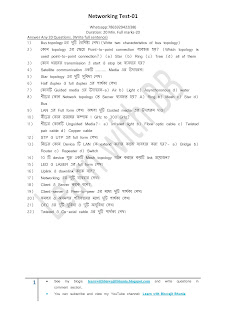Computer Science Syllabus(WBCHSE)
Sequential Logic Circuits: (10 Marks)
Concept of Asynchronous and Synchronous Circuits
Positive and Negative Edge Triggers
Concept of Latch and Flip Flops
SR Flip Flops using NAND and NOR gates
D, JK, T and Master-Slave Flip Flops
Serial and Parallel Registers :
SISO, SIPO, PIPO, PISO
Concept of Asynchronous and Synchronous Counters
Block diagram and working of Asynchronous Counter (Up / Down Ripple Counter)
Block diagram and working of Decade Counter
Block diagram and working of Synchronous Counterfd , ,
Block diagram and working of Ring Counter
Block diagram and working of Johnson Counter
Programming in C and Data Structures: (20 Marks)
Pointers in C- Definition, Pointers and Arrays, Array of Pointers, Pointer to an Array, Pointer and
Strings, Pointer and 2D array, Pointer and Structures, Pointers and Functions, Dynamic Memory Allocation
Command Line Arguments
I/O File Handling in C (Text Files and Binary Files)
Concept of File Pointer
Modes of opening in file
Use of functions open, close, put, puts, print, fgetc, gets, scan, tell, seek, rewind, write, read
Data Structures in C (Both Algorithm and Program)
Single Linked List– Create, Display, Add and Delete Nodes from a List, Search from a list,
Reverse a list (physically reverse a list, display list in reverse order)
Stack using Arrays; Push and Pop Operations
Queue using Arrays; Store and Retrieve Operations (only simple linear queue)
Application of Linked List :
Creating Stack and Queue using Linked List
Application of Stack:
Infix, Prefix and Postfix notations
Infix to Postfix conversion (only conversion using rules, program not required)
Evaluation of Postfix expression (only evaluation using rules, program not required)
Networking: (15 marks)
Introduction to Networking (Definition, Advantage, Disadvantage, Application)
Analogue and Digital Communication
Modes of Communication: Simplex, Half Duplex and Full Duplex Communication
Types of Network – LAN, MAN, WAN
Network Architecture : Client Server & Peer-to-Peer Networks
Serial and Parallel Communication
Bandwidth, Channel Capacity, Baud
Synchronous and Asynchronous Transmission Modes
Baseband and Broadband Networks
Components of a Network
Servers (File server, Communication Server, Print Server) and Workstation
NIC
Guided Media
Cables – UTP, STP, Co-axial, Fibre Optic
Unguided Media
Infra-red, Radio & Microwave Communication, Satellite
Network Operating System – Characteristics
Network Topologies -
Bus
Rind
Star
Mesh
Network Connecting Devices –
Hub
Repeater
Bridge
Switch
Router
Gateways
LAN Protocols
Ethernet (CSMA /CD) and Token Ring Protocol
Switching Technique
Circuit, Message and Packet Switching
Use of MODEM
TCP / IP Protocols
TCP, IP, UDP, FTP, HTTP, TELNET
IP Addressing
Class A, Class B, Class C IP addresses
Domain Name System
URL
Introduction to Internet
Basic requirement for connecting to the Internet, ISP
Services provided by Internet– www, browser, e-mail, search engine, social networking
Networking Security – Computer Virus, Concept of Firewall, Password
HTML
Basic Page Design, Using Ordered and Unordered Lists, Using Image, Hyperlinking, Using
Tables
Database Management System (15 marks)
Introduction of Database :
Definition of Database
Database Languages (DDL, DML, DCL)
DBMS and its components
Various Data Models – ER Model, Hierarchical Model, Network Model, Relational Model
(only concepts)
Relational Model
Concept of Relation, Tuple, Attribute, Domain, Degree, Cardinality
Concept of Keys – Key, Super Key, Candidate Key, Primary Key, Alternate Key
Concept of Relationships – 1:1, 1:N, N:M relationships
Database Constraints – Equity Integrity Constraint, Domain Constraint, Referential Integrity
Constraint and Concept of Foreign Key
Functional Dependency – Full, Partial, Transitive and Trivial Dependencies
Database Anomalies – Insertion, Deletion and Updation Anomaly
Normalisation – Definition, Different Normal Forms (Normalising a Relation up to 3NF)
Relational Algebra
Selection Operation
Projection Operation
Set Operation
Cartesian Product
Natural Join Operation
SQL
CREATE TABLE, ALTER TABLE, DROP TABLE
INSERT, DELETE, UPDATE
SELECT (DISTINCT, FROM, WHERE, AND, OR , IN, NOT, IN, BETWEEN, LIKE, GROUP BY,
HAVING, ORDER BY)
SUM, AVG, COUNT, MAX, MIN
GRANT, REVOKE, ROLLBACK
Introduction to Object Oriented Programming (10 marks)
Basic Concept of OOP
Data Abstraction
Encapsulation
Inheritance
o Polymorphism
Implementing OOP using C++
Basic input / output, branching, looping (simple programs)
Definition of a Class
Members of Class – Data Members and Member Functions;
Concept of Constructor and Destructor (Programming not required)
Object Creation and accessing members of a Class (simple programs)
Practical (30 marks)
Programming in C (Coding, Execution) (10 marks)
One programming problem in C to be developed and tested in computer during the
examination. Marks are allotted on the basis of the following:
Logic (5 marks)
Documentation (2 marks)
Output presentation (3 marks)
Types of problems to be given will be of application type from the following topics:
Linked List manipulation
Stack using array and linked implementation
Queue using array and linked implementation (only linear queue)
Text and Binary File operations (creation, display, searching, modification)
Web Page design using HTML and SQL (command as per theory syllabus) (5 marks)
Project Work (one project using C and one project using HTML) (5 marks)
Suggestive Topics:
Application of C (Program on any one of following topics):
Problem related to Numerical Analysis–Bisection Method, Trapezoidal Rule
Creation and manipulation of telephone index using concept of files
Creation and addition of polynomials using Linked Lists
Web page designing using HTML (minimum 5 linked pages)
Travel and Tourism
Festivals
Book Catalogue
Pollution and pollution control
Laboratory Copy (5 marks)
Viva Voce (5 marks)


Comments
Post a Comment